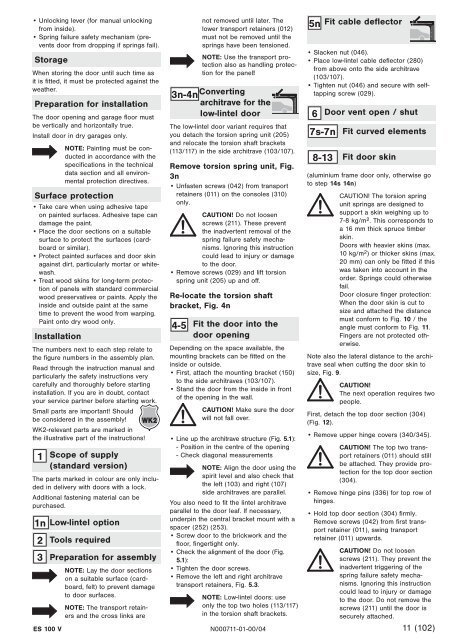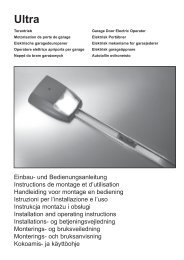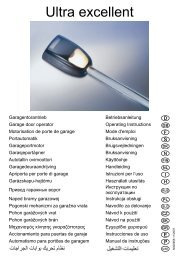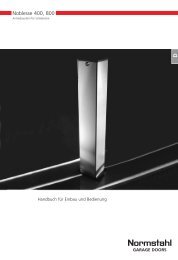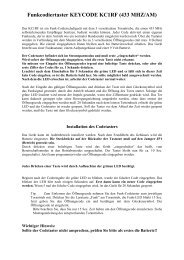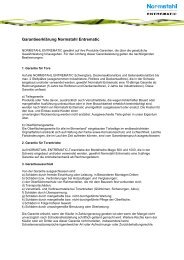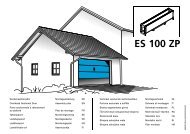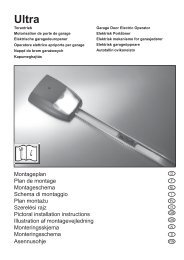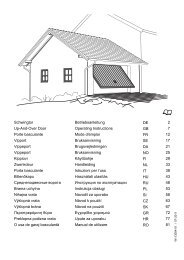Create successful ePaper yourself
Turn your PDF publications into a flip-book with our unique Google optimized e-Paper software.
• Unlocking lever (for manual unlocking<br />
from inside).<br />
• Spring failure safety mechanism (prevents<br />
door from dropping if springs fail).<br />
Storage<br />
When storing the door until such time as<br />
it is fitted, it must be protected against the<br />
weather.<br />
Preparation for installation<br />
The door opening and garage floor must<br />
be vertically and horizontally true.<br />
Install door in dry garages only.<br />
1<br />
1n<br />
2<br />
3<br />
<strong>ES</strong> <strong>100</strong> V<br />
NOTE: Painting must be conducted<br />
in accordance with the<br />
specifications in the technical<br />
data section and all environmental<br />
protection directives.<br />
Surface protection<br />
• Take care when using adhesive tape<br />
on painted surfaces. Adhesive tape can<br />
damage the paint.<br />
• Place the door sections on a suitable<br />
surface to protect the surfaces (cardboard<br />
or similar).<br />
• Protect painted surfaces and door skin<br />
against dirt, particularly mortar or whitewash.<br />
• Treat wood skins for long-term protection<br />
of panels with standard commercial<br />
wood preservatives or paints. Apply the<br />
inside and outside paint at the same<br />
time to prevent the wood from warping.<br />
Paint onto dry wood only.<br />
Installation<br />
The numbers next to each step relate to<br />
the figure numbers in the assembly plan.<br />
Read through the instruction manual and<br />
particularly the safety instructions very<br />
carefully and thoroughly before starting<br />
installation. If you are in doubt, contact<br />
your service partner before starting work.<br />
Small parts are important! Should<br />
be considered in the assembly!<br />
WK2-relevant parts are marked in<br />
the illustrative part of the instructions!<br />
Scope of supply<br />
(standard version)<br />
The parts marked in colour are only included<br />
in delivery with doors with a lock.<br />
Additional fastening material can be<br />
purchased.<br />
Low-lintel option<br />
Tools required<br />
Preparation for assembly<br />
NOTE: Lay the door sections<br />
on a suitable surface (cardboard,<br />
felt) to prevent damage<br />
to door surfaces.<br />
NOTE: The transport retainers<br />
and the cross links are<br />
3n-4nConverting<br />
architrave for the<br />
low-lintel door<br />
4-5<br />
not removed until later. The<br />
lower transport retainers (012)<br />
must not be removed until the<br />
springs have been tensioned.<br />
NOTE: Use the transport protection<br />
also as handling protection<br />
for the panel!<br />
The low-lintel door variant requires that<br />
you detach the torsion spring unit (205)<br />
and relocate the torsion shaft brackets<br />
(113/117) in the side architrave (103/107).<br />
Remove torsion spring unit, Fig.<br />
3n<br />
• Unfasten screws (042) from transport<br />
retainers (011) on the consoles (310)<br />
only.<br />
CAUTION! Do not loosen<br />
screws (211). These prevent<br />
the inadvertent removal of the<br />
spring failure safety mechanisms.<br />
Ignoring this instruction<br />
could lead to injury or damage<br />
to the door.<br />
• Remove screws (029) and lift torsion<br />
spring unit (205) up and off.<br />
Re-locate the torsion shaft<br />
bracket, Fig. 4n<br />
Fit the door into the<br />
door opening<br />
Depending on the space available, the<br />
mounting brackets can be fitted on the<br />
inside or outside.<br />
• First, attach the mounting bracket (150)<br />
to the side architraves (103/107).<br />
• Stand the door from the inside in front<br />
of the opening in the wall.<br />
CAUTION! Make sure the door<br />
will not fall over.<br />
• Line up the architrave structure (Fig. 5.1):<br />
- Position in the centre of the opening<br />
- Check diagonal measurements<br />
NOTE: Align the door using the<br />
spirit level and also check that<br />
the left (103) and right (107)<br />
side architraves are parallel.<br />
You also need to fit the lintel architrave<br />
parallel to the door leaf. If necessary,<br />
underpin the central bracket mount with a<br />
spacer (252) (253).<br />
• Screw door to the brickwork and the<br />
floor, fingertight only.<br />
• Check the alignment of the door (Fig.<br />
5.1):<br />
• Tighten the door screws.<br />
• Remove the left and right architrave<br />
transport retainers, Fig. 5.3.<br />
NOTE: Low-lintel doors: use<br />
only the top two holes (113/117)<br />
in the torsion shaft brackets.<br />
N000711-01-00/04<br />
5n<br />
6<br />
7s-7n<br />
8-13<br />
Fit cable deflector<br />
• Slacken nut (046).<br />
• Place low-lintel cable deflector (280)<br />
from above onto the side architrave<br />
(103/107).<br />
• Tighten nut (046) and secure with selftapping<br />
screw (029).<br />
Door vent open / shut<br />
Fit curved elements<br />
Fit door skin<br />
(aluminium frame door only, otherwise go<br />
to step 14s 14n)<br />
CAUTION! The torsion spring<br />
unit springs are designed to<br />
support a skin weighing up to<br />
7-8 kg/m 2 . This corresponds to<br />
a 16 mm thick spruce timber<br />
skin.<br />
Doors with heavier skins (max.<br />
10 kg/m 2 ) or thicker skins (max.<br />
20 mm) can only be fitted if this<br />
was taken into account in the<br />
order. Springs could otherwise<br />
fail.<br />
Door closure finger protection:<br />
When the door skin is cut to<br />
size and attached the distance<br />
must conform to Fig. 10 / the<br />
angle must conform to Fig. 11.<br />
Fingers are not protected otherwise.<br />
Note also the lateral distance to the architrave<br />
seal when cutting the door skin to<br />
size, Fig. 9.<br />
CAUTION!<br />
The next operation requires two<br />
people.<br />
First, detach the top door section (304)<br />
(Fig. 12).<br />
• Remove upper hinge covers (340/345).<br />
CAUTION! The top two transport<br />
retainers (011) should still<br />
be attached. They provide protection<br />
for the top door section<br />
(304).<br />
• Remove hinge pins (336) for top row of<br />
hinges.<br />
• Hold top door section (304) firmly.<br />
Remove screws (042) from first transport<br />
retainer (011), swing transport<br />
retainer (011) upwards.<br />
CAUTION! Do not loosen<br />
screws (211). They prevent the<br />
inadvertent triggering of the<br />
spring failure safety mechanisms.<br />
Ignoring this instruction<br />
could lead to injury or damage<br />
to the door. Do not remove the<br />
screws (211) until the door is<br />
securely attached.<br />
11 (102)


